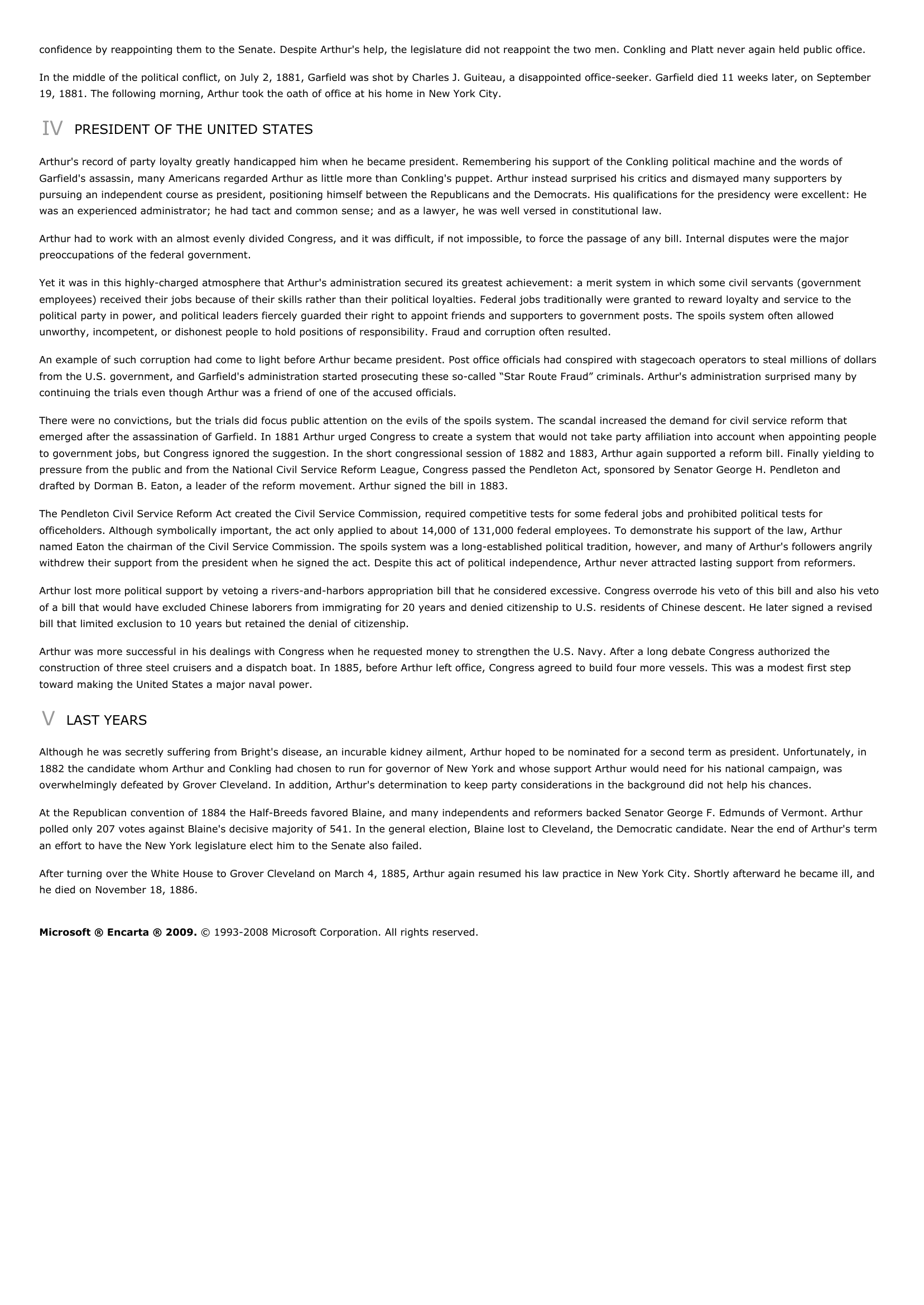Chester Arthur.
Publié le 10/05/2013

Extrait du document
«
confidence by reappointing them to the Senate.
Despite Arthur's help, the legislature did not reappoint the two men.
Conkling and Platt never again held public office.
In the middle of the political conflict, on July 2, 1881, Garfield was shot by Charles J.
Guiteau, a disappointed office-seeker.
Garfield died 11 weeks later, on September19, 1881.
The following morning, Arthur took the oath of office at his home in New York City.
IV PRESIDENT OF THE UNITED STATES
Arthur's record of party loyalty greatly handicapped him when he became president.
Remembering his support of the Conkling political machine and the words ofGarfield's assassin, many Americans regarded Arthur as little more than Conkling's puppet.
Arthur instead surprised his critics and dismayed many supporters bypursuing an independent course as president, positioning himself between the Republicans and the Democrats.
His qualifications for the presidency were excellent: Hewas an experienced administrator; he had tact and common sense; and as a lawyer, he was well versed in constitutional law.
Arthur had to work with an almost evenly divided Congress, and it was difficult, if not impossible, to force the passage of any bill.
Internal disputes were the majorpreoccupations of the federal government.
Yet it was in this highly-charged atmosphere that Arthur's administration secured its greatest achievement: a merit system in which some civil servants (governmentemployees) received their jobs because of their skills rather than their political loyalties.
Federal jobs traditionally were granted to reward loyalty and service to thepolitical party in power, and political leaders fiercely guarded their right to appoint friends and supporters to government posts.
The spoils system often allowedunworthy, incompetent, or dishonest people to hold positions of responsibility.
Fraud and corruption often resulted.
An example of such corruption had come to light before Arthur became president.
Post office officials had conspired with stagecoach operators to steal millions of dollarsfrom the U.S.
government, and Garfield's administration started prosecuting these so-called “Star Route Fraud” criminals.
Arthur's administration surprised many bycontinuing the trials even though Arthur was a friend of one of the accused officials.
There were no convictions, but the trials did focus public attention on the evils of the spoils system.
The scandal increased the demand for civil service reform thatemerged after the assassination of Garfield.
In 1881 Arthur urged Congress to create a system that would not take party affiliation into account when appointing peopleto government jobs, but Congress ignored the suggestion.
In the short congressional session of 1882 and 1883, Arthur again supported a reform bill.
Finally yielding topressure from the public and from the National Civil Service Reform League, Congress passed the Pendleton Act, sponsored by Senator George H.
Pendleton anddrafted by Dorman B.
Eaton, a leader of the reform movement.
Arthur signed the bill in 1883.
The Pendleton Civil Service Reform Act created the Civil Service Commission, required competitive tests for some federal jobs and prohibited political tests forofficeholders.
Although symbolically important, the act only applied to about 14,000 of 131,000 federal employees.
To demonstrate his support of the law, Arthurnamed Eaton the chairman of the Civil Service Commission.
The spoils system was a long-established political tradition, however, and many of Arthur's followers angrilywithdrew their support from the president when he signed the act.
Despite this act of political independence, Arthur never attracted lasting support from reformers.
Arthur lost more political support by vetoing a rivers-and-harbors appropriation bill that he considered excessive.
Congress overrode his veto of this bill and also his vetoof a bill that would have excluded Chinese laborers from immigrating for 20 years and denied citizenship to U.S.
residents of Chinese descent.
He later signed a revisedbill that limited exclusion to 10 years but retained the denial of citizenship.
Arthur was more successful in his dealings with Congress when he requested money to strengthen the U.S.
Navy.
After a long debate Congress authorized theconstruction of three steel cruisers and a dispatch boat.
In 1885, before Arthur left office, Congress agreed to build four more vessels.
This was a modest first steptoward making the United States a major naval power.
V LAST YEARS
Although he was secretly suffering from Bright's disease, an incurable kidney ailment, Arthur hoped to be nominated for a second term as president.
Unfortunately, in1882 the candidate whom Arthur and Conkling had chosen to run for governor of New York and whose support Arthur would need for his national campaign, wasoverwhelmingly defeated by Grover Cleveland.
In addition, Arthur's determination to keep party considerations in the background did not help his chances.
At the Republican convention of 1884 the Half-Breeds favored Blaine, and many independents and reformers backed Senator George F.
Edmunds of Vermont.
Arthurpolled only 207 votes against Blaine's decisive majority of 541.
In the general election, Blaine lost to Cleveland, the Democratic candidate.
Near the end of Arthur's terman effort to have the New York legislature elect him to the Senate also failed.
After turning over the White House to Grover Cleveland on March 4, 1885, Arthur again resumed his law practice in New York City.
Shortly afterward he became ill, andhe died on November 18, 1886.
Microsoft ® Encarta ® 2009. © 1993-2008 Microsoft Corporation.
All rights reserved..
»
↓↓↓ APERÇU DU DOCUMENT ↓↓↓
Liens utiles
- Chester Alan Arthur - Biography.
- Chester Arthur I INTRODUCTION Chester Arthur (1829-1886), 21st president of the United States (1881-1885), who gained the presidency when President James A.
- Arthur, Chester Alan
- Explication linéaire A la Musique Arthur Rimbaud, Poésies, 1870-1871
- Ophélie d’Arthur Rimbaud










